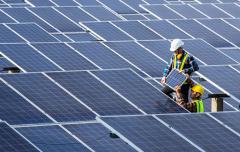Powering the Sustainable Development Goals
Halfway through the 2030 Agenda for Sustainable Development, the United Nations released their progress report The Sustainable Development Goals Report 2023 that paints a sobering picture. It states that “we are leaving more than half the world behind” with 48 percent of the 138 evaluated Sustainable Development Goals (SDGs) among 169 being moderately or severely off track, while over 30 percent have either seen no movement or even regressed below the 2015 baseline (Figure 1). This level of progress is not acceptable, but investing in sustainable energy for all can increase progress on the SDGs.
In this article, we introduce a new sustainable development pathway in the Powering the Sustainable Development Goals, which seeks to jointly promote and deliver the SDGs by investing in SDG7 as the key enabler of developmental and environmental outcomes. The evidence base shows that action on SDG7 can accelerate progress on other SDGs and create tangible results for the energy, climate, and development agendas.
SDG7 progress (Figure 1) is not sufficient, such that in 2030, without significantly increased investment, some 660 million people will remain without electricity, 2 billion people will remain without clean cooking, renewable energy will account for only a fraction of the world’s energy consumption, and energy efficiency improvement will be far below the targeted goal. Meanwhile, the window of opportunity to limit the rise in global temperatures to 1.5 degrees Celsius (SDG13) is closing fast, as warned by the Intergovernmental Panel on Climate Change (IPCC). Investing in sustainable energy, as called for by SDG7, is essential to climate progress.
Figure 1: Progress assessment for 17 Sustainable Development Goals, 2023 or latest data (%)
Source: The United Nations, The Global Sustainable Development Report 2023 and Progress Chart 2023
The 2023 UN report also states that under current trends, 575 million people will still be living in extreme poverty (SDG1), some 84 million children will be out of school in 2030 (SDG4), and it will take 286 years to close gender gaps in legal protection (SDG5). The report also makes it clear that developing countries and the world’s poorest and most vulnerable people bear the biggest consequences – exacerbated by a failure to act on SDG13 that will increase and complicate humanitarian crises.
Continuing on the same path will not yield the targeted results. We need a new approach that urgently pivots the way we think about how to advance and achieve the SDGs. One high-potential approach is to pursue synergy between multiple SDGs, to advance them simultaneously in a more resource-efficient and economically and socially impactful manner. The UNDESA (United Nations Department of Economic and Social Affairs) and UNFCCC (United Nations Framework Convention on Climate Change) report on Synergy Solutions for a World in Crisis: Tackling Climate and SDG Action Together claims that by maximizing synergies, we can also bridge investment gaps worth trillions of dollars. In addition, making a “systematic and replicable” approach can maximize speed of delivery and cost reduction opportunities by learning from previous experiences and reinforcing the impacts of economies of scale.
The UN Global Sustainable Development Report 2019 mentioned that SDG7 influences other SDGs more than it is influenced by other SDGs. The report also noted that SDG7 had more co-benefits than trade-offs for other SDGs, while another study revealed that there were more than twice as many synergies than trade-offs (143 synergies, 65 trade-offs) between SDG7 and other goals.
So, what is the role of SDG7 in this type of synergy-focused approach to increase the speed of advancing the SDGs? For example, how can we better leverage enhanced access to clean and affordable energy to promote socio-economic development? How should we think of clean and affordable energy service provision in a way that leads to greater agricultural output and the delivery of nutrition, industrial productivity, better access to modern and efficient healthcare, effective education, and water and sanitation services, while reducing negative environmental and planetary impacts?
SDG7: Clean, efficient and affordable energy is a key SDG enabler
Clean, efficient and affordable energy is a vital physical input and enabler for the achievement of many SDGs. Although empirical studies on the impacts between energy service provision and social and economic outcomes are quite mixed and often inconclusive,[1] it is intuitive to see that without clean and affordable energy, many business and household activities are impossible or very labour-intensive, harmful to the environment, and warm the planet. Energy is difficult to replace, and without clean and affordable energy, many SDG achievements could cease to exist or be virtually impossible.
A conceptual diagram (Figure 2) examines a sustainable development pathway engaging SDG7 activities to simultaneously initiate and spur actions to advance other SDGs, as a new synergy-focused approach. In this pathway, SDG7 maximizes its power as a key enabler by empowering and transforming specific value chain activities with potential high impacts across the entire system that are currently bottlenecked without clean and affordable energy services.
Figure 2: A Powering Sustainable Development Pathway
Note: This diagram does not indicate proven causal directions, impact levels or timespan of creating outcomes and impacts between SDG7 and other SDGs, nor does it cover feedback and complex causal mechanisms. It only shows potential forward linkages that SDG7 can initiate and influence to advance other SDGs.
Improving energy services supports the development of infrastructure, facilities, and services necessary for diverse business and social activities, contributing to the advancement of multiple SDGs. The pathway is particularly relevant to SDGs such as SDG2 (Zero Hunger, Nutrition, Sustainable Agriculture), SDG3 (Good Health and Well-being), SDG4 (Quality Education), and SDG6 (Clean Water and Sanitation) and SDG11 (Sustainable Cities and Communities), as they can become conduits to advancing other planetary, social, and economic outcomes such as SDG5 (Gender Equity), SDG8 (Decent Work and Economic Growth), SDG10 (Reduced Inequity) and SDG13 (Climate Action). SDG7 is also an important enabler of Business, Industry and Economy SDGs 8, 9 and 12) and together can be the means for receiving the social and planetary outcomes expected from SDGs 1, 5, 10, 13, 14 and 15.
The Powering the Sustainable Development Goals mainly focuses on forward linkages that SDG7 can initiate and influence, without showing complex interlinkages, synergies, and trade-offs between SDG7 and the other SDGs. It is important to recognize that this complexity in the real world means that providing renewable energy, energy efficiency or electricity access for homes or economic and social infrastructure alone cannot necessarily bring desired social, economic and environmental outcomes. However, simultaneously engaging in multiple Powering the Sustainable Development Goals initiatives can enhance diverse socio-economic and physical factors, which then create an enabling environment for advancing the desired outcomes of multiple SDGs. With these aspects in mind, we explore strong and positive links between energy and developmental outcomes.
Sustainable Development Goals dependent on SDG7
SDG2: Zero Hunger
Moderate or severe food insecurity affected about 2.4 billion people in 2022, over 29 percent of the world’s population, with higher incidence in rural areas and among women. Of the staggering 1.2 billion tonnes of food that were lost in 2019, approximately 22 percent was concentrated in low-income food deficit countries, indicating a widening food supply gap for large segments of vulnerable populations.
In terms of energy use, agri-food production in many developing countries is energy-inefficient – ranging from 0.1 to as much as 27.4 kg of food produced per kilowatt hour (equivalent) of energy used in 54 countries analysed by SEforALL. In addition, the sector remains heavily reliant on fossil fuels, with recent studies estimating that food systems account for at least 15 percent of global fossil fuel use.
Adoption of energy-efficient practices in agriculture, enabled by clean and affordable energy, can improve countries’ food security and resilience by increasing productivity and market access for agri-food producers, and reducing post-harvest losses and emissions. Solar irrigation in African countries, for instance, can increase farmers’ incomes by 42 percent, while reducing groundwater use and increasing productivity. Renewable-powered and efficient cold and heat chains help create, preserve and deliver nutritious food products. Effective cold chains can prevent up to 30 percent food waste and 15 percent in smallholder farmers’ income losses.
The Food and Agriculture Organization (FAO) has identified several energy-related interventions in agri-food systems that support the achievement of SDG2 without breaching the 1.5°C threshold. These include transitioning from traditional to sustainable modern bioenergy; investing in sustainable cooling solutions; shifting small-scale producers towards solar-powered irrigation, drying and cold storage; and improving the energy efficiency of equipment, business practices and transportation. The transformation of local agriculture supply chains (i.e., seeding, planting, irrigation, crop and livestock caring, harvesting, storing and delivering to consumers) would reduce food and fuel imports, which would mean more value is retained locally and reinvested to start a virtuous cycle of economic growth.
Initiatives to support SDG2 (Zero Hunger)

Productivity can be increased through the electrified mechanization of food production (land cultivation, crop seeding, planting, irrigation, caring, harvesting, livestock feeding and caring), cold chain food storage, distribution, and sales of nutritious food, by renewable energy. Impacts include increasing agricultural yields, expanding available markets, increasing sustainability, increasing food producers’ incomes, and empowering them to service local and international food and nutrition goals.

Electrified cold chains with renewable energy, covering storage, processing, packaging, and distribution of food support the consumption of fresh foods, which have more diverse and greater nutritional values compared to currently common grain-heavy diets. Meanwhile, clean cooking helps reduce air pollution and labour time to collect cooking fuels.
SDG3: Good Health and Well-being
Universal access to sustainable energy is vital for global health and well-being, and swiftly transitioning from fossil fuels to clean energy yields significant health co-benefits. Deaths from fossil fuel-related air pollution decreased from 1.4 million in 2005 to 1.2 million in 2020, predominantly due to reduced coal pollution. Within households, air pollution caused by cooking stoves and fuels is responsible for 3.2 million deaths every year. The cost of inaction in clean cooking on health is estimated at USD 1.4 trillion annually. Risks intensify when considering polluting energy use for heating, lighting and other purposes, and disproportionately affect women and children.
Amidst escalating climate threats, the safety and resilience of populations worldwide also depends on electrified healthcare facilities and reliable medical cold chains. Yet, 25 percent of vaccines are wasted due to poor or non-existent cold chains, and nearly 1 billion people are served by healthcare facilities that lack reliable electricity. In South Asia and Sub-Saharan Africa, 12 percent and 15 percent of facilities lack electricity respectively, jeopardizing life-saving care. Many off-grid hospitals and clinics rely on diesel-powered generators, which are unreliable, expensive to operate, and environmentally harmful. As more facilities get electrified, energy use in the healthcare industry, already equivalent to 5-8 percent of global energy consumption, is expected to increase.
Technological trends in solar photovoltaic systems, batteries and remote monitoring are making healthcare electrification more cost-effective and sustainable, but ample opportunities remain untapped, particularly in the adoption of energy-efficient medical appliances.
Initiative to support SDG3 (Good Health and Well-being)

Reliable renewable electricity is essential for preventive healthcare and medical treatment, including testing, screening, diagnostics, treatment, vaccine and medicine cold chains. It also supports information and knowledge exchange for doctors and patients. The result is enhanced diagnostics, improved treatment and lives saved by making healthcare, modern medical equipment and appliances locally accessible.
SDG4: Quality Education
Globally, 186 million children attend primary schools without any electricity (one in four primary schoolchildren). Regionally, Sub-Saharan Africa has the lowest rate of primary school access to electricity at 31 percent, followed by South Asia and Latin America. Electrifying both homes and educational facilities can increase study hours by increasing productivity and substituting for labour intensive, time-consuming work, while enhancing the quality of education by providing comfortable study environment through improved lighting and temperature control and access to IT-based education and information materials and equipment.
Electricity consumption and educational outcomes have strong relationships. A 2008 study of 120 countries found a strong correlation between electricity consumption per capita and higher scores on the education index. SEforALL examined the relationship between electricity consumption per capita and expected years of schooling for 114 developed and developing countries, showing positive relationships between electricity consumption and educational outcomes (Figure 3).
More importantly, at lower levels of electricity consumption per capita, even a small increase of electricity consumption correlates to the significant rise in schooling years. In particular, the steep increase of schooling years up to the Modern Energy Minimum threshold of 1000 kWh per capita per year indicates the importance of providing and improving electricity access in low-income countries if we want to advance education there.
Although electricity access or higher electricity consumption alone does not guarantee increasing educational outcomes, the benefits and synergies of pursuing them together are clear (Figure 3). A 2018 study by the Inter-American Development Bank (IADB) on Light for All in Schools (LFAS, “Luz para Todos nas Escolas”) Program on 6,912 schools in Brazil showed that schools that were electrified had a 28 percent lower drop-out rate compared to unelectrified schools.
Figure 3: Relationship between electricity consumption and expected years of schooling, 114 countries (2017-21)
Note: The 2021 annual electricity consumption data by US Energy Information Administration (EIA) were used for the analysis, as they were the most recent data available at the time of writing. When expected years of schooling data were not available for 2021, the latest data available between 2017 and 2020 for each country and corresponding year’s electricity consumption data were used to enhance the robustness of the chart with as many data points as possible. A total of 114 countries (developing countries, i.e., lower-middle income and upper-middle income countries by the 2023 World Bank categorization, as well as developed countries) were examined. Iceland data were removed as it showed as a strong outliner.
Data sources: US Energy Administration Information (EIA), World Bank Development Indicators
Initiative to support SDG4 (Quality Education)

The quality of education is improved by electrifying energy services by renewable energy, including clean cooking, improved lighting, temperature control, smart learning technologies (computers and internet) for educational facilities, especially at primary schools, secondary schools and homes for students. Impacts include enhancing students’ learning environment, improving the student’s well-being to study, play and interact for greater learning, providing special learning opportunities by modernized science labs and libraries, while boosting instructors’ teaching capacity by providing access to modern equipment.
SDG6: Clean Water and Sanitation
Electricity is a key input to increase water access, as it modernizes all supply chain activities of water and sanitation services, i.e., extraction of source water, treatment, transport, and delivery to diverse human water demands, and treatment of wastewater before returning to the environment.[2] The International Energy Agency (IEA) estimated that electricity consumption in the water sector for processing was 978 TWh in 2020 (approximately 3.7 percent of total electricity consumption), set to increase to 1252 TWh in 2030 and 1473 TWh in 2040. The IEA reported 80 percent of wastewaterwas discharged untreated, but the electricity consumption of wastewater treatment process would increase from 222 TWh in 2020 to 287 TWh in 2030 and 314 TWh in 2040, indicating it is very important to provide efficient electricity service to this process to advance SDG6 worldwide.
Meanwhile, more than 2.1 billion people still lack access to safely managed drinking water services worldwide (2022). Many are in rural areas: in Sub-Saharan Africa, 84 percent of the rural population lacks clean drinking water access (2022) while 70 percent also lacks electricity access (2021), meaning that there is likely to be significant overlap between those populations. Low levels of electricity consumption correspond to low levels of access to safe drinking water; even a very modest increase of electricity use corresponds to significant increases in access to safe drinking water, and this is particularly strong under the Modern Energy Minimum threshold (Figure 4).
Figure 4: Relationship between electricity consumption and safe drinking water, 102 countries (2021)
Note: A total of 102 countries (developing countries, i.e., lower-middle income and upper-middle income countries by the 2023 World Bank categorization, as well as developed countries) were examined.
Data sources: US Energy Administration Information (EIA), World Bank Development Indicators
Initiative to support SDG6 (Clean Water and Sanitation)

Renewable electrification powers clean water distribution activities, such as raw water intake, water treatment, clean water production, and water distribution to users. Impacts include introducing clean water services to currently unserved communities due to lack of electricity access, improving the quality of water in a sustainable manner for all communities.
SDG11: Sustainable Cities and Communities
The IEA indicates that urban areas account for two-thirds of global energy consumption, yet over 135 million people living in urban areas lack access to electricity worldwide. Evidence from Ethiopia suggest that many urban households are in Tier 3 or 4 of electricity access – enough to power an essential bundle of energy services and higher-load appliances, such as refrigerators – but power outages and limited hours of service prevent them from reaching Tier 5 electricity access, necessary to power energy-intensive services like air conditioning or a heater.
Projecting unmet energy demand allows to better target urban electrification interventions and de-risk investments, including in low-income and informal settlements. With global temperatures on the rise, the construction and operation of energy-efficient buildings is crucial to ensure thermal comfort and enhance community resilience and well-being.More than half of the built floor area that will necessitate cooling in 2050 is yet to be built, principally in developing economies. This presents a historic opportunity to invest in buildings’ efficiency, electrification of heating and cooking, solar thermal application, and efficient end-use equipment to deliver on the nexus of SDG7 and SDG11.
The IPCC 6th Assessment Synthesis Report emphasized how green and blue infrastructure can provide local cooling, reduce energy consumption and limit risk from extreme weather events, but still receives lower investments than grey infrastructure.[3] Sustainability and energy and resource efficiency in urban areas can also be advanced by reducing rural-urban migration through rural community electrification, which improves basic service provision and increases economic opportunities in rural areas.
Finally, a shift to electric mobility and efficient modes of transport is key to improving air quality and reduced urban emissions. For instance, Nigeria’s Energy Transition Plan shows that a 20 percent reduction in travel by passenger car through mode-shifting and a 60 percent market penetration of electric vehicles will align the transport sector with the country’s pathway to net zero by 2060.
Initiatives to support SDG11 (Sustainable Cities and Communities

Building electrification with renewable energy along with advancing demand flexibility, energy efficiency, sustainable cooling and urban planning can support improved habitats for people and businesses in communities. Impacts include increased resiliency to climate disaster or financial fluctuation, adaptation to rapidly increasing temperatures, improved air quality in the community, and better quality of life.

Transport sector electrification with renewable energy along with implementation models for electric public transport, electric passenger vehicles, and charging infrastructure can increase options for sustainable mobility. Impacts include pathways to reduce environmental and climate impacts from the transport sector, while providing affordable mobility for cities and communities.
Interactions between the SDGs and the benefits of pursuing them together with SDG7
There are also important interactions between multiple SDGs targeted by the Powering the Sustainable Development Goals. For example, one in three schools worldwide had either limited or no drinking water service and 698 million children lacked basic sanitation service at their schools, and energy is required to provide clean water and sanitation at sites for water pumping and powering sanitation equipment. When many children do not have enough nutritious food to eat at home, school lunch programmes could provide them with much-needed nutrition, but this requires functioning kitchen facilities with access to electricity, clean cooking, clean water, and sanitation. Similarly, cooling solutions in schools – such as efficient ceiling fans or cool roofs – protect students and teachers during the hottest hours and can enhance learning outcomes. Thus, targeting SDG6 (Clean Water and Sanitation) and SDG7 (Electrification, Energy Efficiency and Clean Cooking) to provide a package of services at primary and secondary schools is a rational solution, which could enhance not only SDG4 (Quality Education) but also SDG3 (Good Health and Well-being) and SDG2 (Zero Hunger, Nutrition).
Business, Industry and Economy SDGs
Energy service provision has long been considered as one of the – if not the – key drivers of industrialization and economic growth, both in developed and developing economies. Similarly, transitions to sustainable energy are expected to stimulate green economic growth and industrial development. Energy is a prerequisite for many economic development-related SDGs. Clean and affordable energy is an important input for clean and responsible production in various industrial and service sectors and the consumption of goods and services, including the realization of a circular economy.
Promoting energy and resource efficiency are fundamental to reducing resource waste and environmental footprints, the core of SDG12 advancement (SDG12: Responsible Consumption and Production). SDG7 can also directly support diverse economic activities by spurring productivity and efficiency, hence economic growth, which then increases decent jobs, including clean energy sector jobs (SDG8: Decent Work and Economic Growth). Sustainable industrialization and development of resilient infrastructure needs reliable energy systems with limited environmental impacts, and industrial sectors are a powerhouse of innovation for clean energy technologies, services and business opportunities (SDG9: Industry, Innovation and Infrastructure).
Such economic development-related SDGs have important interactions (Figure 2). For example, increasing productivity in agricultural cold chains and irrigation systems will help modernize and transform agriculture supply chains and industry, thereby building a foundation for strong local economic growth to advance SDGs 8 and 9.
Meanwhile, improved health and education through Powering Healthcare and Powering Education supports the development of human capital for sustainable industry capacity, which is vital for continuous and breakthrough innovations in technology, markets, industry, and policy (SDG9). Conversely, SDG9 advancements in infrastructure and industry are necessary for the development of most industrial, commercial and social sectors.
Initiative to support SDGs 8, 9 and 12 (Business, Industry and Economy)

Electrifying high value-added business activities with renewable energy to trigger a cycle of economic development. This includes a focus on developing sustainable and effective industry value chain through clean energy services and cold chains rather than looking at individual activities or equipment in silo. Impacts include increasing income to be reinvested locally, strengthening local industry, creating business opportunities, decent jobs, developing transferable skills and improved infrastructure.
Social Outcome SDGs
The Powering the Sustainable Development Goals can support achieving positive social outcomes toward the advancement of SDG1 (No Poverty), SDG5 (Gender Equality), and SDG10 (Reduced Inequality). Among the USD 1.4 trillion estimated cost of inaction of clean cooking on health, women bear a disproportional share of USD 0.8 trillion. Clean electricity and cooking access can cut time spent on labour-intensive household and economic activities, including collecting biomass fuels and water, and increase productivity and reduce poverty as a result. Women and children in many places spend on average 1.4 hours a day collecting solid fuels (i.e., wood, crop wastes, charcoal, coal or dung). A recent study estimates that 389 million women and girls undertake collecting biomass for cooking (and some for heating) for both rural and urban areas in 92 developing countries, mentioning that they “would represent the largest labor segment of today’s global energy system”, and “women household biomass producers outnumber men”, particularly in Sub-Saharan Africa.
Clean energy access contributes to a reduction of inequality by relieving women and vulnerable communities from time and health burdens and providing them the time and energy for more productive, educational and/or leisure activities. In addition, women represent a significant share of agricultural workers – even surpassing 50 percent in 23 countries in Africa and Asia – and post-harvest activities are often part of women’s traditional responsibilities. Therefore, modern productive assets powered by energy access can increase their agricultural outputs and yields, with positive effects on food security.
Similarly, greater access to electricity services can improve women’s and children’s health and well-being, while just and equitable transitions create entrepreneurship opportunities for women. Furthermore, a UNDP modeling study on achieving universal electricity access by 2030, combined with an ambitious development programme across all SDGs, shows that such efforts can lift 110 million people out of extreme poverty by 2030 and an additional 163 million by 2050.
Improved energy efficiency can be a game-changer for the population living under the poverty line and underserved communities. Energy efficiency measures such as improved insulation or efficient appliances, reduce the strain on the grid and maximize energy from renewable sources. Lower energy bills free up resources for food, healthcare and education, thereby improving overall household quality of life. As energy efficient measures are adopted, energy gains can increase modern energy uses, reducing drudgery, saving time and contributing to women empowerment.
Small-scale renewable energy projects, such as solar mini-grid and solar home systems, can provide electricity access affordably and quickly to remote communities, which are difficult to reach by extending the main electricity grid or expensive to reach with fuels. Renewable energy is also an excellent resiliency booster, providing energy independence from main grid breakdowns or fuel supply disruptions or price fluctuations caused by disasters.
Planetary Outcomes SDGs
The Powering the Sustainable Development Goals can also support achieving positive planetary outcomes, specifically those targeted by SDG13 (Climate Action), SDG14 (Life Below Water), and SDG15 (Life on Land). SDG7 has a direct and critical connection with SDG13 (Climate Action) because sustainable, affordable and modern energy is fundamental to reducing greenhouse gas (GHG) emissions.
In addition, clean and affordable energy supports both SDG14 (Life Below Water) and SDG15 (Life on Land), namely biodiversity conservation, sustainable land use, and freshwater or marine ecosystem management.[4] Holistic approaches to clean energy development can bring huge environmental benefits by reducing energy-related environmental hazards and pollution to protect biodiversity and ecosystems for many species.
Importantly, as countries seek to close energy access gaps by 2030 and provide modern energy services to all populations, equally rapid shifts to renewable energy and energy efficiency are fundamental to avoid locking in carbon emissions and further climate risks.
Support Action SDGs
Last but not least, SDG16 (Peace, Justice and Strong Institutions) and SDG17 (Partnership for the Goals) are essential pre-conditions to support all other SDGs, and are fundamental to Powering Sustainable Development Goals through SDG7.
Any consensus-based actions for achieving the SDGs requires SDG16 including a peaceful environment and equal access to justice. Effective institutions, including good policy and regulations, decent trading environment, as well as functional market mechanisms, are the backbone of developing all economic sectors. Inclusiveness in decision making encourages contribution by all members of the society and create a strong sense of accountability on all SDG actions. To advance sustainable development, Just and Equitable Energy Transitions must contribute to effective institutions and inclusive decision-making. Additionally, they should support global energy governance systems that strongly involve developing countries.
To advance multiple SDGs simultaneously through SDG7, forming multi-stakeholder partnerships (SDG17) across the different goals and the key stakeholder becomes critical. Systematic, resource-efficient, and economically and socially impactful outcomes cannot be delivered without vigorous actions in capacity development, additional finance, and science and technology development and sharing, including through North-South and South-South cooperation.
Together, peace, justice strong institutions and partnerships are essential and together with sustainable energy can “power” achieving the SDGs.
Moving Forward
There is a real opportunity to leverage accelerated progress on SDG7 to ‘power’ the advancement of other SDGs. Meanwhile, not accelerating SDG7 will have significant consequences on SDG13, which will then negatively impact the advancement of other SDGs. Thus, initiating diverse potential co-benefits and outcomes through the forward linkages created by SDG7, SEforALL plans to engage in the Powering the Sustainable Development Goals, trying to stimulate synergies and maximize social and economic opportunities for all.
1| The inconclusiveness of energy’s impacts on social and economic outcomes by past empirical studies shows the difficulty of capturing a full range of complex causal factors, multiple impact mechanisms and interactions, and specific local contexts, which all affect the outcomes. This complexity, in addition to methodological and data deficiency, has made it difficult to produce consistent results across diverse contexts in the past empirical studies.
2| Energy and water systems are highly interdependent. In addition to electricity as a critical input to mobilize the water supply chain, the global energy system uses approximately roughly 10 percent of total global freshwater withdrawals. Water is used in various phases of energy production: hydropower generation depends on water as a direct input; thermal and nuclear power plants use water for cooling; and biofuel production uses water through agriculture and forestry feedstock production.
3| According to the IPCC, green infrastructure includes planted and remnant native vegetation, soils, wetlands, parks and green open spaces, as well as building and street-level design interventions that incorporate vegetation, while blue infrastructure includes bodies of water, watercourses, ponds, lakes and storm drainage, that provide ecological and hydrological functions including evaporation, transpiration, drainage, infiltration and temporarily storage of runoff and discharge. Grey infrastructure is defined as the engineered physical components and networks of pipes, wires, roads and tracks that underpin energy, transport, communications (including digital), built form, water and sanitation, and solid-waste management systems.
4| According to the UN 2019 report, SDG7 has more trade-offs with SDG15 than synergies, while approximately a third of influences of SDG7 on SDG14 is also trade-offs. A good example of a trade-off is the negative impact of clean energy development, such as bioenergy and hydropower, on water and land resources and management and biodiversity. Complex interlinkages between SDG7 and the two goals, therefore, need to be manage carefully with holistic frameworks.
